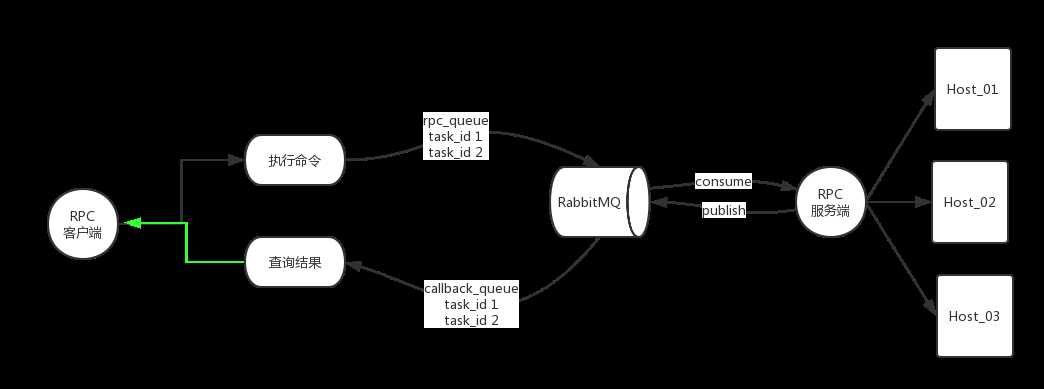标签:输出 else inf cat event iss highlight 任务 配置
基于RabbitMQ RPC实现的主机异步管理
地址原文:http://blog.51cto.com/baiying/2065436,作者大大,我把原文贴出来了啊。不要告我
root@ansible:~/workspace# tree ManageHost/
ManageHost/
├── environment
│ ├── base_dir.py
│ ├── base_dir.pyc
│ └── __init__.py
├── README.md
├── RPC_Client
│ ├── bin
│ │ ├── __init__.py
│ │ └── start.py
│ ├── conf
│ │ ├── __init__.py
│ │ ├── __init__.pyc
│ │ ├── settings.py
│ │ └── settings.pyc
│ ├── core
│ │ ├── __init__.py
│ │ ├── __init__.pyc
│ │ ├── main.py
│ │ └── main.pyc
│ ├── __init__.py
│ ├── __init__.pyc
│ └── modules
│ ├── client.py
│ ├── client.pyc
│ ├── __init__.py
│ └── __init__.pyc
└── RPC_Server
├── conf
│ ├── __init__.py
│ ├── __init__.pyc
│ ├── settings.py
│ └── settings.pyc
├── __init__.py
├── __init__.pyc
└── server.py
来个README.md
root@ansible:~/workspace/ManageHost# cat README.md
1、需求
- [ ] 利用RibbitMQ进行数据交互
- [ ] 可以对多台服务器进行批量操作
- [ ] 执行命令后不等待命令的执行结果,而是直接让输入下一条命令,结果出来后自动打印
- [ ] 实现异步操作
备注
- [ ] RabbitMQ队列:
①执行命令时,队列名为“rpc_queue2”
②查询数据时,用的是回调时随机生成的callback_queue名
③conf/settings——Rabbitmq地址“192.168.17.102”,端口:5672,用户名:admin,密码:admin
- [ ] SSH:
RPC_Server/server.py——paramiko操作连接的测试Linux默认端口22,用户名:root,密码:123456
- [ ] threading多线程:
实现命令执行后不等待执行结果,依然可以输入新的指令
- [ ] 执行命令格式:
-->>run ifconfig host 192.168.20.22 192.168.20.23
dir server端要执行的命令
host host后可跟一个或多个可以通过rabbitMQ的服务器地址
- [ ] 查看后台所有的TASK_ID信息:
-->>check_task
显示结果样式:TASK_ID【76786】 HOST【192.168.20.22】 COMMAND【dir】
TASK_ID【10307】 HOST【192.168.20.23】 COMMAND【dir】
- [ ] 查看TASK_ID对应的执行结果:
-->>get_task 10307
程序目录结构:
├── README.md
├── RPC_Client
│ ├── bin
│ │ ├── __init__.py
│ │ └── start.py #客户端启动程序
│ ├── conf
│ │ ├── __init__.py
│ │ ├── __pycache__
│ │ │ ├── __init__.cpython-36.pyc
│ │ │ └── settings.cpython-36.pyc
│ │ └── settings.py
│ ├── core
│ │ ├── __init__.py
│ │ ├── main.py
│ │ └── __pycache__
│ │ ├── __init__.cpython-36.pyc
│ │ └── main.cpython-36.pyc
│ └── modules
│ ├── client.py
│ ├── __init__.py
│ └── __pycache__
│ ├── client.cpython-36.pyc
│ └── __init__.cpython-36.pyc
└── RPC_Server
├── conf
│ ├── __pycache__
│ │ └── settings.cpython-36.pyc
│ └── settings.py
└── server.py #server端启动程序
程序启动:
客户端启动:RPC_Client/bin/start.py
服务端启动:RPC_Server/server.py
1)先来看看client代码
这个是入口
root@ansible:~/workspace/ManageHost/RPC_Client/bin# cat start.py
#!/usr/bin/env python
# coding:utf-8
import os
import sys
import platform
if platform.system() == ‘Windows‘:
BASE_DIR = ‘\\‘.join(os.path.abspath(os.path.dirname(__file__)).split(‘\\‘)[:-1])
else:
BASE_DIR = ‘/‘.join(os.path.abspath(os.path.dirname(__file__)).split(‘/‘)[:-1])
sys.path.append(BASE_DIR)
from core import main
if __name__ == ‘__main__‘:
handle = main.Handle()
handle.start()
可以看到最终执行会在main中,看看main中的代码
root@ansible:~/workspace/ManageHost/RPC_Client/core# cat main.py
#!/usr/bin/env python
# coding:utf-8
import pika
import random
import threading
from modules import client
from conf import settings
class Handle(object):
def __init__(self):
self.connection = pika.BlockingConnection(pika.ConnectionParameters(
host=settings.RabbitmqHost,credentials=settings.credentials,
))
self.channel = self.connection.channel()
def run_cmd(self,cmd,host):
rpc_client = client.Client(self.connection,self.channel)
task_id = str(random.randint(1000,9999))
response = rpc_client.call(cmd,host)
self.corr_id = response[1]
print "Task_id" ,task_id
print "callback_queue:%s, corr_id: %s" %(response[0],response[1])
self.info[task_id] = [self.corr_id,host,cmd,response[0],response[1]]
def start(self):
self.info = {}
help = """
命令格式:
执行系统命令: run command host eg: run ls 172.20.6.184
查看所有执行任务: check_task
查看指定任务结果: get_task id eg: get_task 6723
"""
print(help)
while True:
msg = raw_input(‘>>‘).strip()
if msg.startswith(‘run‘) and len(msg.split()) >= 3:
cmd = msg.split()[1]
# 多线程运行
th_join = []
for host in msg.split()[2:]:
th = threading.Thread(target=self.run_cmd,args=(cmd,host,),)
th.start()
th_join.append(th)
for t in th_join:
t.join()
elif msg == ‘check_task‘:
if not self.info:
print "没有任务队列"
continue
else:
for taskid,task in self.info.items():
print "TaskID [%s] Host [%s] COMMAND [%s]" %(taskid,task[1],task[2])
elif msg.startswith(‘get_task‘):
rpc_client = client.Client(self.connection, self.channel)
if msg.split()[1] in self.info:
task_id = msg.split()[1]
callback_queue = self.info[task_id][3]
correlation_id = self.info[task_id][4]
print callback_queue,correlation_id
task_result = rpc_client.get_task(callback_queue,correlation_id)
del self.info[task_id]
print "小行星",task_result.decode().strip()
else:
print "输入的task ID 不存在!"
continue
elif not msg:
continue
else:
print "输入错误,请重新输入!"
continue
看到了,start()方法是入口,会检测你的输入,如果是以run开头的,解析你输入的参数,如果以check_task开头会怎样...
root@ansible:~/workspace/ManageHost/RPC_Client/modules# cat client.py
#!/usr/bin/env python
# coding:utf-8
import pika
import random
import uuid
class Client(object):
def __init__(self,connection,channel):
self.connection = connection
self.channel = channel
# 对回调队列中的响应进行处理的函数
def on_response(self,channel,method,props,body):
print self.correlation_id,props.correlation_id
if self.correlation_id == props.correlation_id:
self.response = body
return self.response
channel.basic_ack(delivery_tag=method.delivery_tag)
def get_task(self,callback_queue,correlation_id):
self.response = None
self.correlation_id = correlation_id
print "=====callback_queue:%s,-------correlation_id:%s" %(callback_queue,correlation_id)
# 客户端订阅回调队列,当回调队列中有响应时,调用on_response方法对响应进行处理
self.channel.basic_consume(self.on_response,queue=callback_queue)
while self.response is None:
self.connection.process_data_events()
return self.response
def call(self,cmd,host):
# 声明回调队列,再次声明的原因是客户端和服务器端不知道谁先被启动,该声明是幂等的
# 多次声明,只生效一次
result = self.channel.queue_declare(exclusive=True)
self.callback_queue = result.method.queue
msg = cmd + ‘ ‘ + ‘‘.join(host)
print msg
self.corr_id = str(uuid.uuid4())
# 发送RPC请求内容到RPC请求队列rpc_queue中,同时发送的还有reply_to ,correlation_id
self.channel.basic_publish(exchange=‘‘,routing_key=‘rpc_queue2‘,
properties=pika.BasicProperties(
reply_to=self.callback_queue,
correlation_id=self.corr_id,
),
body=msg)
print "callback_queue:%s, corr_id:%s" %(self.callback_queue,self.corr_id)
return self.callback_queue,self.corr_id
看看配置文件吧
root@ansible:~/workspace/ManageHost/RPC_Client/conf# cat settings.py
#!/usr/bin/env python
# coding:utf-8
import pika
import os
import sys
import platform
if platform.system() == ‘Windows‘:
BASE_DIR = ‘\\‘.join(os.path.abspath(os.path.dirname(__file__)).split(‘\\‘)[:-1])
else:
BASE_DIR = ‘/‘.join(os.path.abspath(os.path.dirname(__file__)).split(‘/‘)[:-1])
sys.path.append(BASE_DIR)
RabbitmqHost = ‘172.20.6.184‘
RabbitmqUser = ‘admin‘
RabbitmqPwd = ‘admin‘
credentials = pika.PlainCredentials(RabbitmqUser,RabbitmqPwd)
2)看看server端的代码吧
root@ansible:~/workspace/ManageHost/RPC_Server# cat server.py
#!/usr/bin/env python
# coding:utf-8
import pika
import paramiko
import os
import sys
import platform
if platform.system() == ‘Windows‘:
BASE_DIR = ‘\\‘.join(os.path.abspath(os.path.dirname(__file__)).split(‘\\‘)[:-1])
else:
BASE_DIR = ‘/‘.join(os.path.abspath(os.path.dirname(__file__)).split(‘/‘)[:-1])
sys.path.append(BASE_DIR)
from RPC_Server.conf import settings
connection = pika.BlockingConnection(pika.ConnectionParameters(
host=settings.RabbitmqHost, credentials=settings.credentials,
))
channel = connection.channel()
channel.queue_declare(queue=‘rpc_queue2‘)
# 数据处理方法
def exec_cmd(cmd,host):
ssh = paramiko.SSHClient()
ssh.set_missing_host_key_policy(paramiko.AutoAddPolicy())
ssh.connect(hostname=host,port=22,username=‘root‘,password=‘root1234‘,timeout=10)
strin,stdout,stderr = ssh.exec_command(cmd)
stdout_result = stdout.read()
stderr_result = stderr.read()
result = stdout_result if stdout_result else stderr_result
return result.decode()
ssh.close()
# 对RPC请求队列中的请求进行处理
def on_request(ch, method, props, body):
cmd = body.split()[0]
print body
host = body.split()[1]
host = ‘%s‘%host
# 调用数据处理方法
response = exec_cmd(cmd,host)
# 将处理结果(响应)发送到回调队列
ch.basic_publish(exchange=‘‘,
routing_key=props.reply_to,
properties=pika.BasicProperties(correlation_id = props.correlation_id),
body=str(response))
print "callback_queue: %s, corr_id: %s" %(props.reply_to,props.correlation_id)
ch.basic_ack(delivery_tag=method.delivery_tag)
channel.basic_consume(on_request, queue=‘rpc_queue2‘)
print(" [x] Awaiting RPC requests")
channel.start_consuming()
配置文件:
root@ansible:~/workspace/ManageHost/RPC_Server# cat conf/settings.py
#!/usr/bin/env python
# coding:utf-8
import pika
import os
import sys
import platform
if platform.system() == ‘Windows‘:
BASE_DIR = ‘\\‘.join(os.path.abspath(os.path.dirname(__file__)).split(‘\\‘)[:-1])
else:
BASE_DIR = ‘/‘.join(os.path.abspath(os.path.dirname(__file__)).split(‘/‘)[:-1])
sys.path.append(BASE_DIR)
RabbitmqHost = ‘172.20.6.184‘
RabbitmqUser = ‘admin‘
RabbitmqPwd = ‘admin‘
credentials = pika.PlainCredentials(RabbitmqUser,RabbitmqPwd)
能不能解释解释:

1、run命令过程解析
为什么说这个作者写的是一个异步的主机管理呢,实际上,当你在执行
1)run ls 172.20.6.184的时候,start()方法会检测到是以run开头的,然后会解析cmd和hosts参数,然后使用多线程执行run_cmd()方法
2)run_cmd()方法会调用client模块中的类,初始化一个rpc_client对象,这个对象只会建立一个channel,接着使用random生成一个task_id任务id,然后调用rpc_client对象中的call()方法
3)call()方法,首先创建要给callback_queue的临时队列,得到ls 172.20.6.184作为msg发送到rpc_queue2的队列中,并指定接收消息的队列为callback_queue,server端订阅了rpc_queue2的队列,然后触发on_request()方法,这个方法,会解析msg的内容并得到cmd和hosts,然后执行exec_cmd()方法,exec_cmd()这个方法,使用paramiko这个模块,处理结果,on_request()方法把结果发送到callback_queue的队列中。
4)我们需要注意的是,这里仅仅只是把结果发送到callback_queue的队列中,run这个并没有接收这个消息,call()只是得到了callback_queue和corr_id,然后把结果存入了info这个字典中。然后完成。
2、check_task都做些了啥?
这个更简单了,查了一下info字典,然后把task_id等信息输出给你看。
3、get_task呢?
1)这个是真正干活的了?会接收callback_queue的server端发送过来的处理的结果。具体get_task()方法,这个方法,订阅了callback_queue的消息队列,然后通过response把结果返回
2)然后删除这个task_id,并打印出结果。
思考:所以当我们执行run ls 172.20.6.184的时候,仅仅只是把要执行的内容发送给server端,然后server端返回处理过的数据给callback_queue队列。但是run 不接收结果
真正接收结果的是get_task,所以看起来像是异步吧。
标签:输出 else inf cat event iss highlight 任务 配置
原文地址:https://www.cnblogs.com/wanstack/p/8952797.html